Most people look at guinea pigs as adorable animals suited for family pets and children. But they can also be raised profitably for meat, whether in the backyard or on large-scale farms. These hystricomorph rodents are also known as Cavy or Cuy and they belong to the family Caviidae.
Guinea pigs were first domesticated for food around 5000 BC by tribes in the Andean region of South America. In the sixteenth century, they were introduced into Europe before their popularity grew and spread all across the globe.
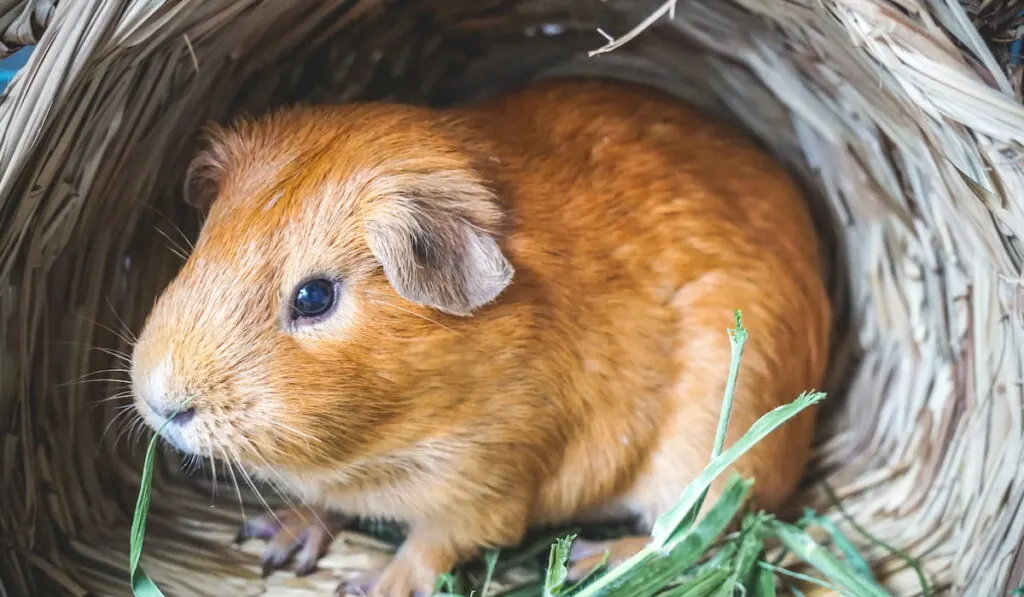
Aside from their delicious taste, guinea pig meat is also high in protein, which makes them suitable for people who are looking for an alternative way to have their own source of meat. In the United States, most guinea pigs that have been brought for consumption come from Peru.
To begin your own journey of raising guinea pigs for meat, there are a few things that you should know in order to successfully farm these animals. Without wasting any time, let’s dive right into it.
Choosing The Best Guinea Pig Breed
Almost all breeds of guinea pigs can be raised for their meat. However, this doesn’t mean one breed is the same as another. There are a few things to consider when choosing the best breed to keep over a longer period of time. For instance:
- Young, large-sized, and healthy guinea pigs always make the best starter cavies.
- Long-haired breeds might yield a lesser amount of meat compared to short-haired breeds.
- Always ask the buyers for a previous record to know about the number of deaths during the weaning process.
- Avoid guinea pigs that have watery and sore eyes, ears, and noses.
- Choose the ones that are active and healthy without any signs of lameness.
- Don’t pick guinea pigs that have sores or any deformities on their bodies.
Once you’re well aware of the do’s and don’ts of choosing a guinea pig, it is for you to look at some of the popular breeds that you can find in the market. Here are the 16 best guinea pig breeds that you can raise:
1. Abyssinian Guinea Pig
The Abyssinian guinea pigs originated from Ethiopia. They can be recognized by their distinctive eight symmetrical swirled furs. They are known to be one of the most affectionate breeds, suitable for beginners and first-time owners.
2. Alpaca Guinea Pig
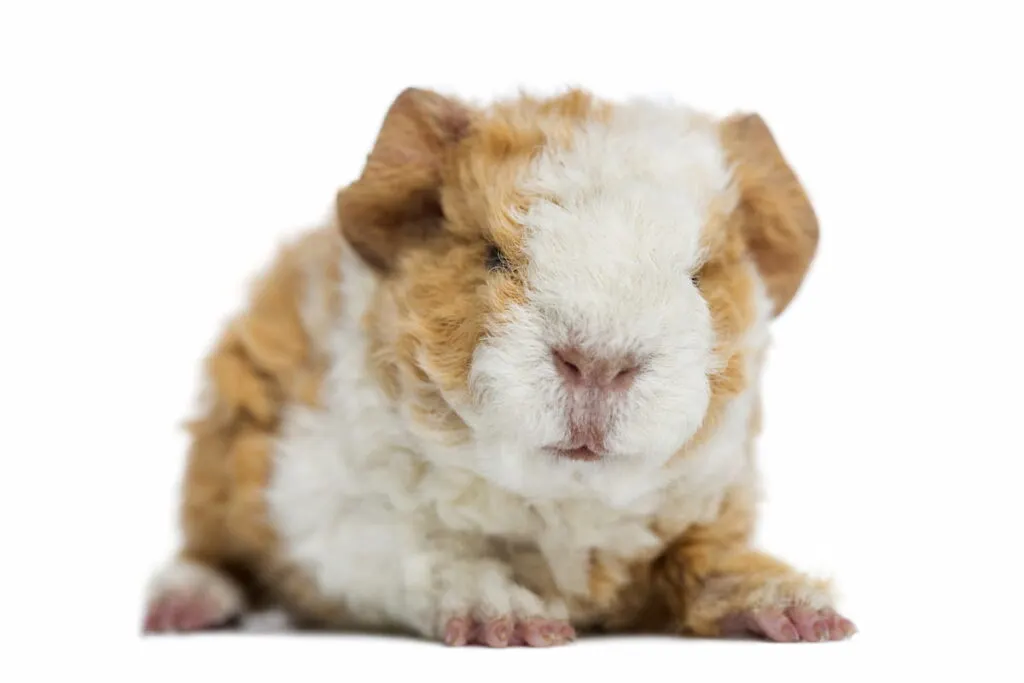
This breed can be recognized by its uniquely dense, wavy, and coarse coat. The Alpaca guinea pigs can live up to 8 years. Raising these rodents requires more attention and care due to their coat type that needs frequent brushing and grooming.
3. American Guinea Pig
The American guinea pigs are the most common breed in North America. They have medium-sized bodies with short hair that comes in 20 different colors. These guinea pigs also don’t require frequent brushing due to their silky coats that are easy to manage. This breed is pretty docile and gets along well with other guinea pigs.
4. Baldwin Guinea Pig
The Baldwin guinea pigs might look like a tiny hippopotamus from afar, but they are actually one of the hairless breeds. However, they still have whiskers on their face. This breed is definitely easy to manage because they don’t require any brushing.
However, without hair, they are prone to experience any sudden changes in temperature, be it hot or cold. Without any insulation to protect their skin, they should also be kept away from direct sunlight.
5. Coronet Guinea Pig
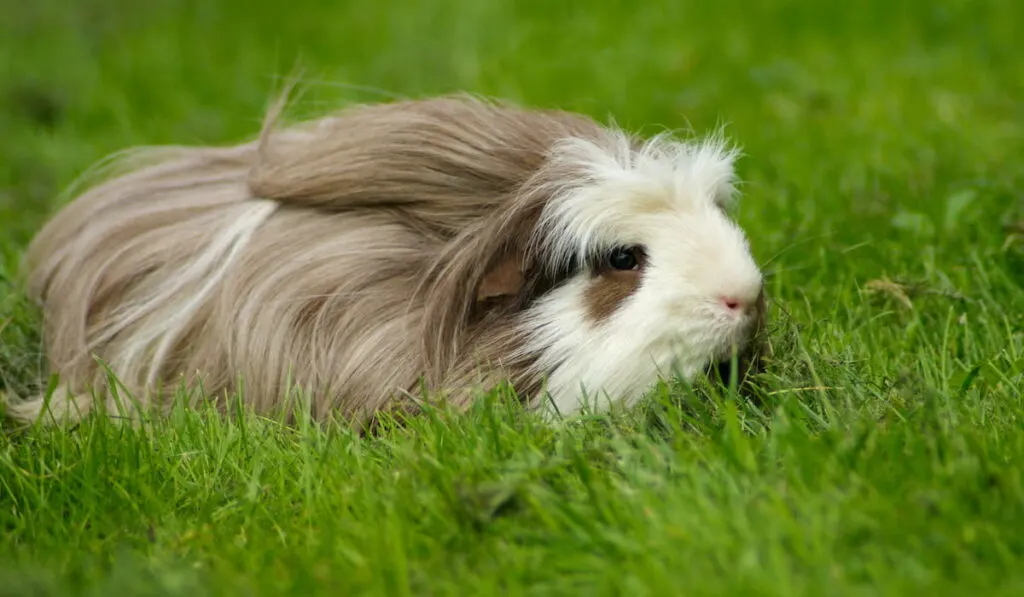
This breed was first bred in the mid-1970s in England by crossing a Silkie guinea pig with an American Crested guinea pig. In 1998, they were first recognized as a breed by the American Rabbit Breeders Association (ARBA). The Coronet guinea pigs can be recognized by their thick, flowing manes that come in many different colors. They are lovely, affectionate, and require a lot of attention from their owners.
6. Himalayan Guinea Pig
The Himalayan guinea pigs are an albino breed with brown and black colorations on their nose, ears, and feet. They have a pure white coat with short fur. These guinea pigs are sensitive to direct sunlight and suitable to be raised in colder regions. They also love to stay indoors. So, people who live in tiny apartments and condos can definitely keep this breed as pets.
7. Lunkarya Guinea Pig
These guinea pigs are native to Sweden. They are the variation of the Peruvian guinea pigs. The Lunkarya guinea pigs can be recognized by their long, mop-like wavy coats that are coarse and dense. They also come in three different sub-breeds which are the Lunkarya Sheltie, Lunkarya Peruvian, and Lunkarya Coronet. Due to their thick coat, these guinea pigs don’t do well in a hot climate or under direct sunlight.
8. Merino Guinea Pig
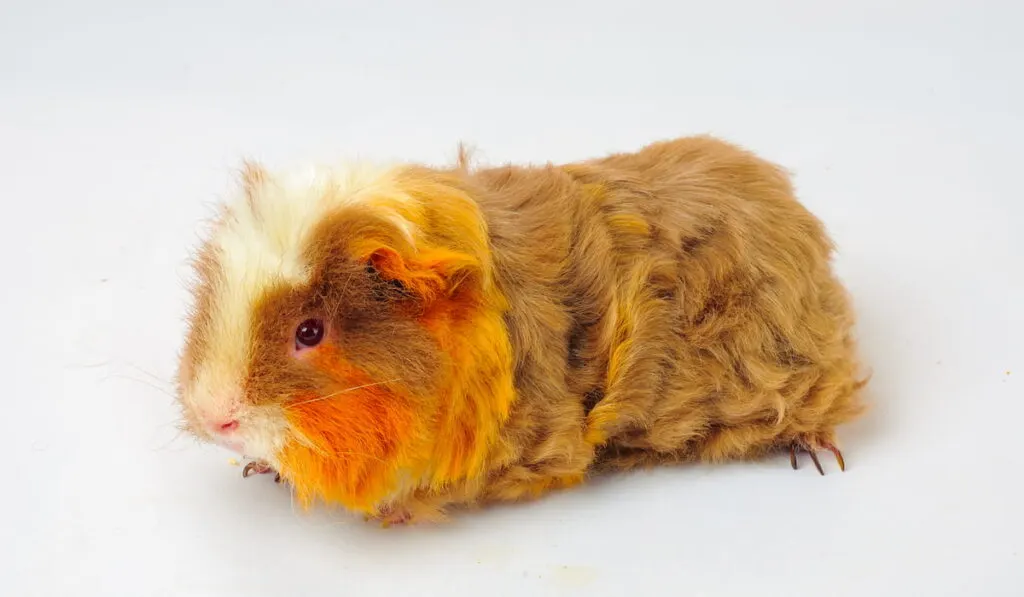
The Merino guinea pigs can be recognized by their distinctive rosette on the forehead. They also have long and thick wavy coats that require regular brushing. These guinea pigs are generally cheerful, intelligent, and adventurous. First-time owners might feel overwhelmed if they choose this breed as starter guinea pigs but over time, the Merinos are definitely more fun and cuddly than other breeds.
9. Peruvian Guinea Pig
The Peruvian guinea pigs can be distinguished by their unique long and wavy coats that can grow up to 2 feet long. Due to the nature of their coat, this breed is considered high maintenance and requires a lot of grooming, bathing, and brushing. These guinea pigs are generally playful, energetic, and curious. They also have a habit of chewing the fur of their companions whenever they feel bored or under-stimulated.
10. Rex Guinea Pig
These guinea pigs may look like hedgehogs but they actually have a short, dense wavy coat that makes them different from other breeds. The Rex guinea pigs come in different color variations ranging from brown, white, and agouti. Although their fur doesn’t require as much grooming as other breeds, their toenails grow quickly and need a lot of trimming from time to time.
11. Sheba Guinea Pig

The Sheba guinea pigs are also known as the Sheba Mini Yaks, meaning the ‘Bad Hair Day’ guinea pigs. They were born from a cross between an Abyssinian and a Peruvian guinea pig. These guinea pigs can be recognized by their long and thick rosette hair that requires frequent grooming and brushing. With their gentle and docile nature, they are fairly easy to handle.
12. Silkie Guinea Pig
Also known as the Shelties, these guinea pigs were first created in the 1970s from a cross between a long-haired Peruvian and a Self-Black guinea pig. They have long, silky thick hair that only grows backward and could reach up to 24 inches long. These guinea pigs are also friendly, warm, and laid-back. To prevent their hair from matting, the Silkies require regular grooming and brushing.
13. Skinny Guinea Pig
The Skinny guinea pigs are one of the hairless breeds with some hair spots on their muzzle, legs, and back. They generally come in three different color forms including Dutch, brindle, and Himalayan. Without any hair to protect their skin, these guinea pigs require a lot of attention and care to prevent any injuries or bruises.
14. Teddy Guinea Pig

These guinea pigs are named after the stuffed animals due to their physical appearance that looks like living teddy bears. Teddy guinea pigs possess short and dense coats that require less maintenance. They could live up to 11 years and weigh up to 3.5 pounds at maturity.
15. Texel Guinea Pig
This breed originated in England and was created from a cross between a Silkie and a British Rex guinea pig. The Texels can be recognized by their long, curly coat that comes in different colors such as white, brown, chestnut, and a mix of other colors. They make a really great pet due to their docile, friendly, and warm temperament.
16. White-Crested Guinea Pig

The White-Crested guinea pigs can be distinguished by a unique white crown on top of their head. The texture of their coat is soft and smooth, which is similar to the American breed. Although they are quite shy and reserved, this breed is fairly intelligent. White-Crested guinea pigs can also be found in Satin, but aren’t being recognized by the American Rabbit Breeders Association (ARBA) as a certified breed.
Housing For Guinea Pigs
Providing a sturdy and safe shelter for your guinea pigs is one of the crucial steps to successfully raise these animals in the long run.
Like many small animals, guinea pigs don’t require large space but there is no harm in providing them with spacious and comfortable shelters. There are two types of housing systems that are suited for guinea pigs. The first one is:
1. Cages/Hutch System
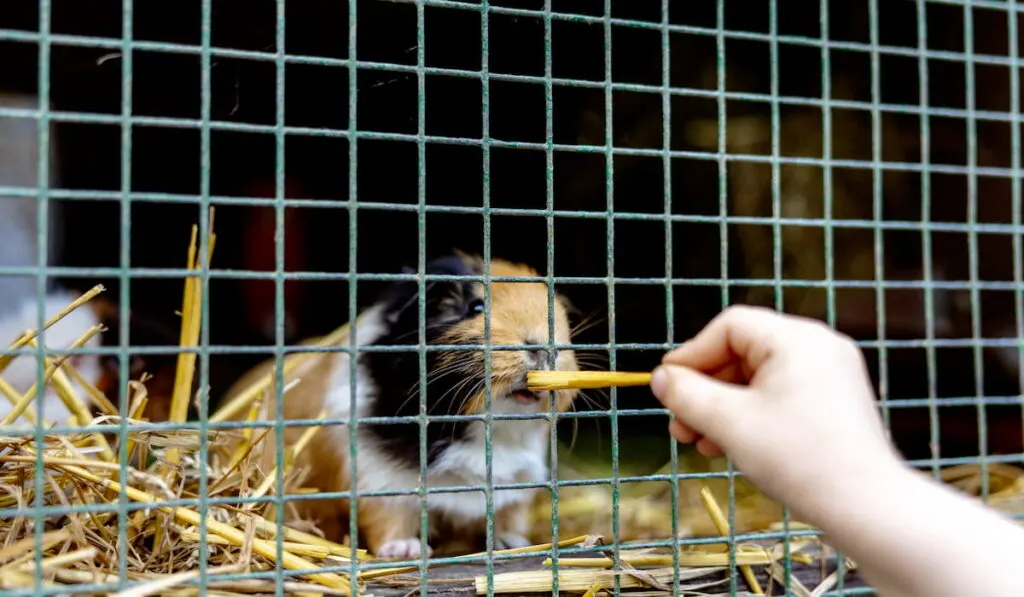
Most commercial cages that are being sold in the market aren’t fit for all types of guinea pigs farming. Depending on their body size and the number of guinea pigs that you want to raise, choosing the right size for their cages or hutches that can accommodate these animals comfortably should be your first priority. For instance:
- One or two guinea pigs require around 7.5 to 10.5 square feet of space (30” x 50”)
- Three guinea pigs require around 10.5 to 13 square feet of space (30” x 62”)
- Four guinea pigs require at least 13 square feet of space (30” x 76”)
These cages can be constructed using different materials such as glass, wood, plastic, metal, and wire. Build solid floors without rough ramps, mesh shelves, or floor grids. This is to avoid any injuries being inflicted on guinea pigs’ feet whenever they run or walk inside their cages.
Aside from floorings, you should also provide beddings for these animals to rest and sleep on. You can use wood shavings, woodchips, and shredded newspapers as long as you keep them fresh and clean. If possible, change their beddings at least once a week. Avoid using sawdust due to the size of the particles that can harm these animals when they accidentally inhale them.
Last but not least, keep your guinea pigs’ cages well-ventilated and free from any moisture. Ideally, you can place their cages in an area that is away from direct sunlight where the surrounding temperature is around 65°F to 75°F. Never place your guinea pigs near any cages of other animals such as rabbits or cats to avoid any infectious disease that can be transmitted between these animals.
The second type of housing that you can build is the pen system:
2. Pen system
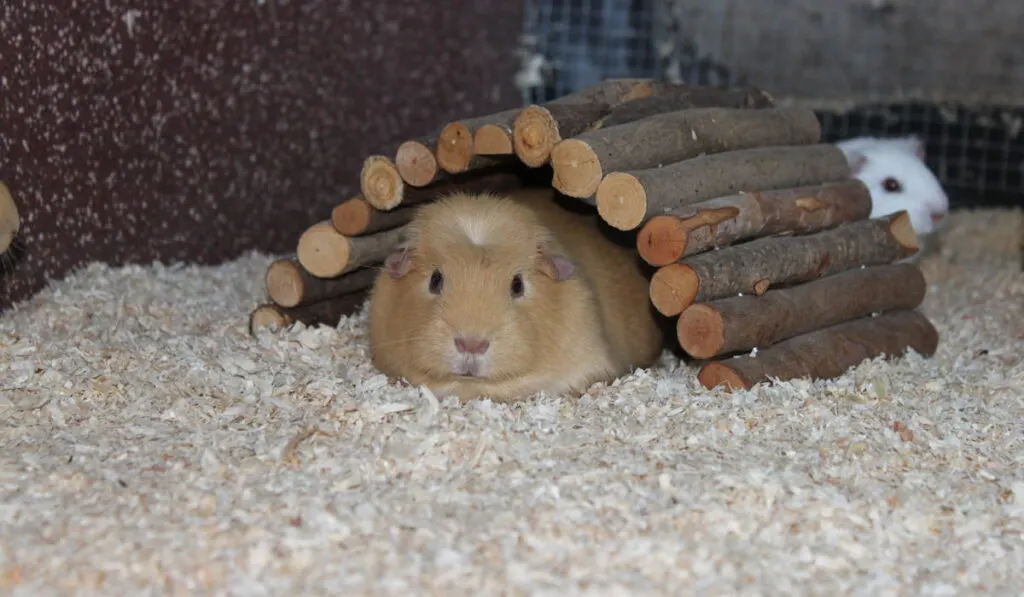
Raising guinea pigs in the pen is more suitable for breeders with a large space, who are looking to maintain a large herd at once. Aside from additional space, the pen system is economical and you don’t have to worry about cleaning their housing regularly. Generally, a 60 square-foot pen can accommodate between 30 and 50 guinea pigs.
You can use hay or sawdust for their beddings. Make sure that these materials are changed regularly to avoid any moisture build-up that can attract bacteria and mold. Don’t forget to cover the pens with strong fences. Additionally, you can also build at least three hiding places that serve to protect these animals whenever they sense any danger from the outside world.
Feeding And Dietary Requirements
Feeding guinea pigs is fairly easy. They are herbivores that mainly feed on plants and grasses out in the wild. When you keep or raise them in your farm and backyard, there are some set of feeding regiment that you can follow.
Basically, you can feed with them high-quality guinea pig hay or guinea pigs pellets. Timothy hay, low-calcium hay, and any specially formulated commercial pellet that contains vitamin C are some of the best diets for these animals.
You can also add fresh vegetables into the mix. These include:
- Broccoli
- Cauliflower
- Romaine lettuce
- Spinach
- Artichokes
- Kale
- Cilantro
- Beet greens
- Carrot tops
- Green and red bell peppers
- Tomatoes
Aside from green plants, you can feed guinea pigs with a small amount of fruits. This is because some fruits contain a high amount of sugar and shouldn’t be fed excessively to these animals. Fruits that are safe for guinea pigs include:
- Apple
- Blueberries
- Kiwi
- Papaya
- Pear
- Orange
- Strawberries
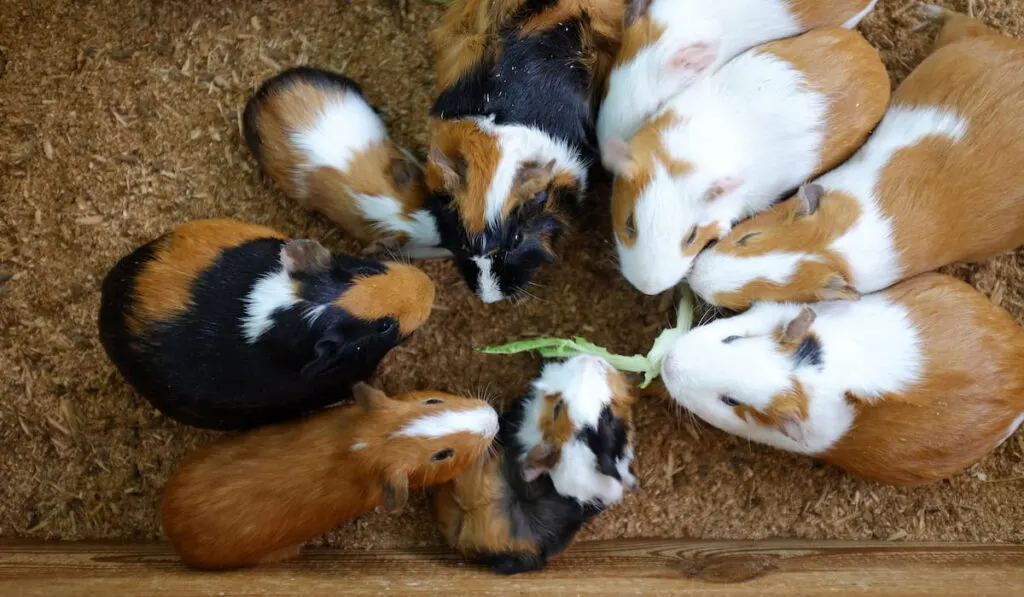
Before feeding any of these vegetables and fruits to your guinea pigs, be sure to wash them thoroughly to remove any traces of pesticides or harmful chemical.
On the other hand, no matter how little the amount could be, there are several foods that aren’t edible for guinea pigs. This is because they can contain a high concentration of sugar or fat, are poisonous, or they can cause bloating and digestion issues. With that said, here are some foods that you should not be given to guinea pigs:
- Chocolate
- Cereals
- Nuts
- Mushrooms
- Garlic
- Onions
- Meat
- Bread
- Dairy products
- Nightshade
- Lilies (any kind)
- Rhubarb leaves
- Foxglove
- Potato tops
- Avocado
- Iceberg lettuce
- Corn kernels
- Peanut butter
- Cabbage
- Oak
- Garden shrubs
As a general rule of thumb, high-quality hay, commercially-formulated pellets with added vitamin C, and fresh vegetables or fruits are more than enough to supply guinea pigs with all the nutrients that they need and help them grow.
How To Breed Guinea Pigs
There comes a time when you know that you are ready to handle more guinea pigs but you don’t want to buy any new ones and introduce them into the herd. So, the only option left is to breed the current ones and let them produce the desired extras. Breeding guinea pigs isn’t hard but it surely takes knowledge and skills.
In general, male guinea pigs are called boars, and females are called sows. Sows can breed at the age of five weeks. However, it is only advisable to breed them when they reach the age of three months or older and weigh around 400 grams.
The boars should also reach an age of three to four months before they can be safely bred. The oestrus (heat) cycle of sows generally lasts around 16 days. During this time, the sows will be interested in the boars for about 8 hours. In this situation, the best thing to do is to give them some space and time for mating. Additionally, you can also notice that the sows will generally elevate her rear end by curving her spine downward or mounting on other guinea pigs.
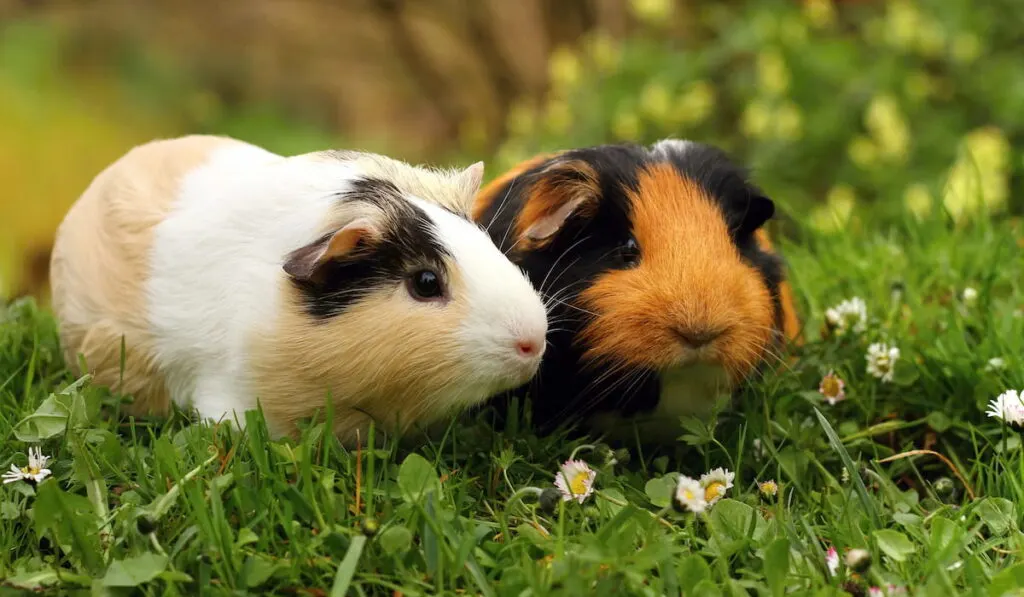
Once they’re pregnant, the sows will take from nine to ten weeks before giving birth to one to six babies. Generally, guinea pigs’ litter size is between two and four piglets. They also develop an obvious bulbous shape and their weight will double.
The sows will also drink more water compared to their normal drinking habit. Keeping the sows’ diet healthy and balanced is also important to prevent any issues that might interfere with their pregnancy. Pregnant sows require more vitamin C compared to what they usually need during their normal days.
Hence, you can feed them with fruits and vegetables that are high in vitamin C such as oranges, strawberries, kales, parsley, brussel sprouts, broccoli, and many more.
It normally takes around one hour for the sows to deliver the piglets if there are no complications or difficulties related to their pregnancy. The piglets can start eating solid food after a few hours of their birth. They generally have hair, open eyes, and teeth.
Health Issues In Guinea Pigs
Guinea pigs are generally hardy and resistant to many diseases. However, you can always monitor and look for any signs of illnesses that can manifest through subliminal changes in their behavior. Oftentimes, they can suffer from some of these common illnesses:
- Alopecia
- Adenovirus infection
- Enlarged lymph nodes
- Respiratory infections
- Broken teeth
- Bumblefoot
- Conjuctivits (pink eye)
- Scurvy (vitamin C deficiency)
- Diarrhea
- Heat stroke
- Metastatic calcification
- Pregnancy toxemia
- Dystocia (difficulty giving birth)
- Reproductive disorders (ovarian cysts and bordetella bacteria)
- Malocclusion
- Tumor
- Abscesses
- Parasite infestations
- Skin problems
- Urinary problems
Some of these diseases might pose a sign for something more serious. If you notice any drastic changes in your guinea pigs, consult a veterinarian as soon as possible to prevent more damage or worse, sudden death in these animals.
Final Thoughts
Raising your own guinea pigs is definitely rewarding if you can successfully raise and manage your own herd in the long run. Aside from being an alternative source of meat, this micro-livestock require a low starting capital, mature faster, and don’t require a large land or space.
Even if you start by treating this activity as a hobby, once you’ve gained enough experience and managed to establish a large number of cavies, you definitely can scale and turn it into a business.
Citations
- https://www.roysfarm.com/guinea-pig-farming
- https://farmhouseguide.com/ultimate-guide-to-raising-guinea-pigs-for-meat
- https://www.guidetoprofitablelivestock.com/howtoraiseguineapigs
- https://afrifarmer.com/guinea-pigs-how-to-start-guinea-pig-farming
- http://scripts.farmradio.fm/radio-resource-packs/package-39-creative-gardening/raising-guinea-pigs-for-meat-or-money
- https://dirtartful.com/2014/11/14/rabbits-vs-guinea-pigs-for-meat-costs-and-considerations-part-1
- https://www.msdvetmanual.com/all-other-pets/guinea-pigs/breeding-and-reproduction-of-guinea-pigs
- https://www.vetzone.com.au/Home/Articles/Article/tabid/1927/ArticleID/246/BreedingGuineaPigs
- https://www.goodhousekeeping.com/life/pets/g25751355/guinea-pig-breeds
- https://www.petco.com/content/petco/PetcoStore/en_US/pet-services/resource-center/food-nutrition/guinea-pig-care-diet-and-feeding-tips
- https://vcahospitals.com/know-your-pet/guinea-pigs-feeding
